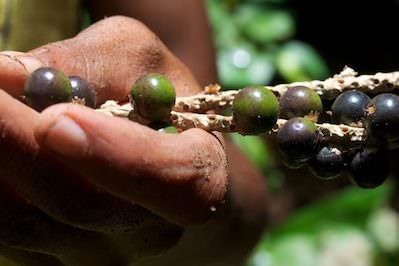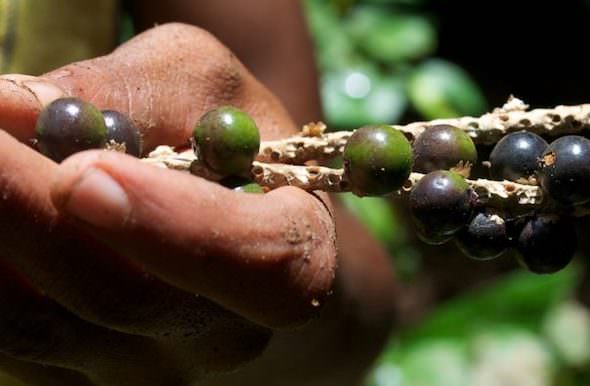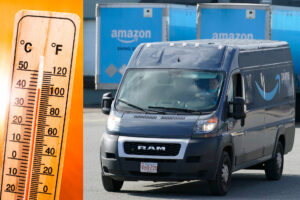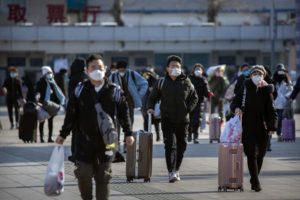Could the Amazon Rainforest Be Saved as a Biological ‘Factory’?
With the world's largest tropical forest under continuous assault, Brazilian scientists propose rescuing it as a kind of lab to help develop biotechnology products.
By Jan Rocha / Climate News Network

The berries of the açaí palm have anesthetic and anti-inflammatory properties. (Kate Evans / CIFOR via Flickr)
SÃO PAULO — Brazilian scientists, alarmed at the ongoing destruction of the Amazon rainforest, have proposed a radical plan to save it.
This would ally the forest’s incredible biodiversity with the new technologies being developed as part of the 4th Industrial Revolution — the name coined for the fusion of technologies that blur the lines between the physical, digital and biological spheres.
The technologies include biomimicry (production of materials by imitating nature – such as solar panels in the pattern of a leaf), gene editing and genomics, nanotechnology, artificial intelligence, robotics, the internet of things (where embedded software enables cars, buildings and other inanimate objects to communicate), and 3D printing.
The world’s largest tropical forest plays a major role in the world’s climate system by storing large stocks of carbon and regulating energy and water fluxes, but it is also a treasure house of species and plants, many of them still unstudied.
The group of scientists — led by Carlos Nobre, a member of the Intergovernmental Panel on Climate Change (IPCC) and co-ordinator of the Centre for Weather Forecasting and Climate Studies at Brazil’s Space Research Institute (INPE) — set out their vision in an article published in the Proceedings of the National Academy of Science.
Rainforest damage
Nobre, supported by Juan Carlos Castilla-Rubio, CEO of the not-for-profit global research organisation, the Planetary Skin Institute, says: “The unsustainable economic model of the last decades in the Amazon — based on changes in land use, deforestation and frequent forest fires, added to extreme climate events that affect the region — are provoking irreversible damage to the rainforest.
“The latest climate models show that, by 2050, half of the Amazon rainforest could be transformed into degraded savannas or seasonable forests, drier and poorer in biodiversity and biomass.”
Their warning is stark: if warming in the region passes 4°C, or more than 40% of the forest is destroyed, “we will reach rupture point in the forest-climate equilibrium”. Only a revolutionary change in patterns of development could prevent this outcome.
They say that this means exchanging the present model — which tries to reconcile conservation with more agriculture and more hydroelectric dams — for a radically different one.
When the technologies emerging from the 4th Industrial Revolution are applied to the active ingredients of the Amazon’s biodiversity, natural processes, molecules, materials and forest ecosystems, the result could be the creation of innovative products and services of high added worth.
“By 2050, half of the Amazon rainforest could be transformed into degraded savannas or seasonable forests, drier and poorer in biodiversity and biomass.”
Nobre says: “We must unite forces in a wide coalition of the public and the private in Brazil and other Amazon countries, creating the best research and development centres, universities, start-ups, visionary companies and governments, with the participation of the peoples of the forest and the region. This is the future.”
An important and often overlooked factor in the new equation is the centuries of knowledge acquired by the indigenous peoples and traditional communities who live in the Amazon. This must be respected and valued.
The scientists gave some examples of plants they say could be developed commercially. For example, the açaí palm (Euterpe oleracea), whose small purple berries are already well known in the US and Europe as a health product, and the jambu plant (Acmella oleracea), whose leaves, branches and flowers are much used in local culinary dishes, contain the alkaloid Spilanthol, known for its anaesthetic and anti-inflammatory properties.
The rainforest would become a giant biotechnological factory, instead of being plundered its natural resources, its timber, minerals and water.
Endangering biodiversity
So far, 50 years of deforestation have converted around 1 million sq kms of Amazon tropical forests to agricultural lands, endangering biodiversity and ecosystem functions.
The average temperature has increased by 1°C, and there have already there have been a number of extreme events this century — two major droughts, and one major flood.
Quite apart from its disastrous effect on the climate, the substitution of forest by agriculture has proved to be economically inefficient, as both cattle and crops are less productive than in other parts of Brazil.
There have been previous attempts to introduce industrialisation into the rainforest, such as the Free Trade Zone in Manaus, which gives tax incentives to subsidiaries of multinational companies to produce electronic goods for sale to the rest of Brazil, using cheap local labour.
The Zone could be anywhere, as it completely ignores local products. But the new proposal is revolutionary because it is entirely based on local products.
Jan Rocha is a freelance journalist living in Brazil and is a former correspondent there for the BBC World Service and The Guardian.
Your support matters…Independent journalism is under threat and overshadowed by heavily funded mainstream media.
You can help level the playing field. Become a member.
Your tax-deductible contribution keeps us digging beneath the headlines to give you thought-provoking, investigative reporting and analysis that unearths what's really happening- without compromise.
Give today to support our courageous, independent journalists.






You need to be a supporter to comment.
There are currently no responses to this article.
Be the first to respond.